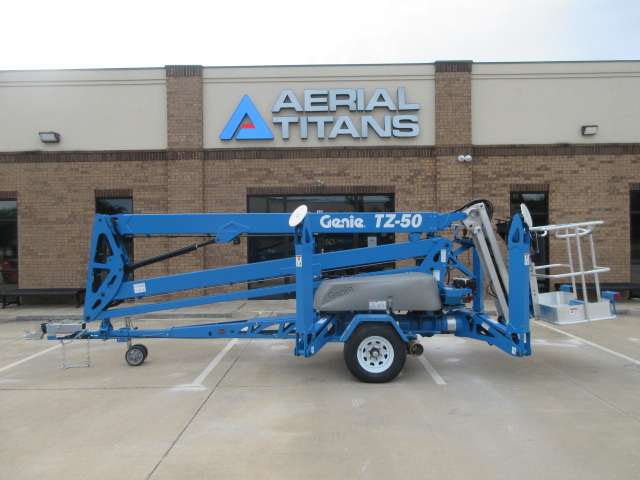
Boom lifts are invaluable machinery used for reaching elevated worksites. They raise a platform or bucket up to the desired area using an arm known as a boom. In this way, workers, equipment, and inventory can reach various heights.
But, not all boom lift types are the same. Before finding the right one, it’s important to fully understand what types of boom lifts are available. One key difference to explore is whether a self-drive or towable boom lift is necessary for a particular project. They vary in movability, so let’s take a closer look at each1. In this article, we’ll explore the differences between self-drive (a type of self-propelled) boom lifts and towable boom lifts.
As the name suggests, towable boom lifts are boom lifts designed to hitch to another vehicle, such as an SUV, to move to a different location. This feature makes towable boom lifts ideal for smaller projects, home renovations, and professional jobs. They are suitable for projects that require up to roughly 50 feet of elevation. This range allows workers to reach tree canopies for landscaping, roof maintenance, hanging decorations and lighting, painting, and other projects.
This boom lift type, like others, requires stability to be effective. Four legs, known as outriggers, extend outward from the base to widen it. Outrigger size affects stability and weight-carrying capability. Manufacturers also specify the types of surfaces to use their towable boom lifts on for safe operation and maximum effectiveness.
The good news is that towable boom lifts aren’t limited to a single boom type. Both articulating and telescoping boom arms are available on towables2.
A self-drive boom lift is a self-propelled boom lift outfitted with outriggers and stabilizers that are more lightweight than other self-propelled options. Most brands carry self-drive boom lifts in limited quantities; however, Niftylift and Haulotte stock larger inventory.
Niftylift’s SD50 model has a platform height of 49 feet, 6 inches3, while the SD64 model reaches 70 feet4. Haulotte model 45 XA’s platform climbs to 45 inches5. The 55 XA model has a platform height of 55 feet, 3 inches6.
In many ways, a self-drive boom lift is similar to a towable boom lift. It features a boom arm capable of various movements, and it lifts workers and platforms to difficult-to-reach places. The main difference is that self-drive boom lifts can move around on their own power and wheels.
The additional mobility makes these boom lifts quicker to move to different parts of a worksite. It only requires a single vehicle, simplifying the setup time before heading to work.
Electric models are ideal for indoor use, as they produce fewer emissions compared to gas-powered models. Diesel boom lifts, on the other hand, are more suitable for outdoor use and may have an easier time navigating challenging terrain in different environments. Just like with towable boom lifts, self-drive options can have a telescoping or articulating boom arm7.
The core functionality between these two types of boom lifts is the same. Both can have different kinds of arms, and both extend outward to raise a work platform. They’re also similar in their safety requirements. In either case, operators must receive training on how to operate the lift correctly. Read manufacturer manuals for maximum weight restrictions and best practices. Workers should also use harnesses, protective rails, and other safety equipment.
Preventive maintenance measures include scheduling regular inspections, performing routine maintenance, and addressing repairs asap. These steps will help your boom lift last longer and prevent hazardous breakdowns8.
For starters, towables require an external vehicle to get from one place to another, while self-drives don’t require assistance. To safely haul a towable, hitch it to a vehicle with a towing capacity of roughly 3,500 pounds. Using a towing vehicle to change sites might add to project costs2.
Self-propelled lifts quickly move from worksite to worksite with minimal setup. Self-drive lifts typically cost more than towables and are more likely to be used for larger projects, as different models can reach heights of over 100 feet. They also have more moving parts that can fail, which can lead to increased maintenance costs over time.
Comparing the benefits of each boom lift and factoring in project needs and budget will help narrow the choices. Then, consider the following.
To use either boom lift safely requires training and the use of protective gear. However, self-propelling lifts have additional best practices for driving operations. With a towable, team members need training on how to use outriggers — especially on uneven ground. In other words, both have unique safety training requirements.
Self-driving boom lifts are likely to have higher upfront and maintenance costs. They will also utilize more fuel. On the other hand, towable boom lifts require a second vehicle with significant towing capacity. Consider whether an additional vehicle rental or purchase is necessary, or if a vehicle is already available. This factor affects the overall operating costs.
When deciding which lift is best, taking a closer look at the worksite can aid the decision-making process. Sometimes, towable boom lifts are better suited for uneven terrain as the adjustable outriggers compensate for the differences in slope. Always read the manufacturer manual for additional guidance.
If you want to minimize the machine’s footprint, a towable option is a great choice. If a particular project requires frequently moving the lift to multiple locations, a self-driving lift is likely the best option1,2.
With a large inventory and fair prices, Aerial Titans is a leading source for various boom lift types and models. The knowledgeable staff has the expertise to answer all your boom lift questions.